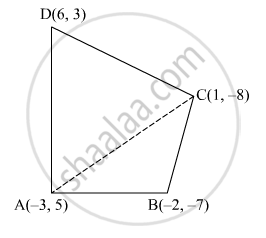Advertisements
Advertisements
Question
If A(−3, 5), B(−2, −7), C(1, −8) and D(6, 3) are the vertices of a quadrilateral ABCD, find its area.
Solution
It is given that A(−3, 5), B(−2, −7), C(1, −8) and D(6, 3) are the vertices of a quadrilateral ABCD.

Area of the quadrilateral ABCD = Area of ∆ABC + Area of ∆ACD
\[\text{ ar } \left( ∆ ABC \right) = \frac{1}{2}\left| x_1 \left( y_2 - y_3 \right) + x_2 \left( y_3 - y_1 \right) + x_3 \left( y_1 - y_2 \right) \right|\]
\[ = \frac{1}{2}\left| - 3\left[ - 7 - \left( - 8 \right) \right] + \left( - 2 \right)\left( - 8 - 5 \right) + 1\left[ 5 - \left( - 7 \right) \right] \right|\]
\[ = \frac{1}{2}\left| - 3 + 26 + 12 \right|\]
\[ = \frac{35}{2}\text{ square units } \]
\[\text{ ar } \left( ∆ ACD \right) = \frac{1}{2}\left| x_1 \left( y_2 - y_3 \right) + x_2 \left( y_3 - y_1 \right) + x_3 \left( y_1 - y_2 \right) \right|\]
\[ = \frac{1}{2}\left| - 3\left( - 8 - 3 \right) + 1\left( 3 - 5 \right) + 6\left[ 5 - \left( - 8 \right) \right] \right|\]
\[ = \frac{1}{2}\left| 33 - 2 + 78 \right|\]
\[ = \frac{109}{2} \text{ square units } \]
∴ Area of the quadrilateral ABCD =\[\frac{35}{2} + \frac{109}{2} = \frac{144}{2} = 72\] square units
Hence, the area of the given quadrilateral is 72 square units.
APPEARS IN
RELATED QUESTIONS
Prove that the points (3, 0), (4, 5), (-1, 4) and (-2, -1), taken in order, form a rhombus.
Also, find its area.
Find the points of trisection of the line segment joining the points:
5, −6 and (−7, 5),
The points (3, -4) and (-6, 2) are the extremities of a diagonal of a parallelogram. If the third vertex is (-1, -3). Find the coordinates of the fourth vertex.
If the point C ( - 2,3) is equidistant form the points A (3, -1) and Bx (x ,8) , find the value of x. Also, find the distance between BC
The midpoint of the line segment joining A (2a, 4) and B (-2, 3b) is C (1, 2a+1). Find the values of a and b.
In what ratio is the line segment joining A(2, -3) and B(5, 6) divide by the x-axis? Also, find the coordinates of the pint of division.
The base QR of a n equilateral triangle PQR lies on x-axis. The coordinates of the point Q are (-4, 0) and origin is the midpoint of the base. Find the coordinates of the points P and R.
Find the area of a quadrilateral ABCD whose vertices area A(3, -1), B(9, -5) C(14, 0) and D(9, 19).
Find the coordinates of the centre of the circle passing through the points P(6, –6), Q(3, –7) and R (3, 3).
The perpendicular distance of the P (4,3) from y-axis is
\[A\left( 6, 1 \right) , B(8, 2) \text{ and } C(9, 4)\] are three vertices of a parallelogram ABCD . If E is the mid-point of DC , find the area of \[∆\] ADE.
If P (x, 6) is the mid-point of the line segment joining A (6, 5) and B (4, y), find y.
Find the area of triangle with vertices ( a, b+c) , (b, c+a) and (c, a+b).
If the points (k, 2k), (3k, 3k) and (3, 1) are collinear, then k
If (−1, 2), (2, −1) and (3, 1) are any three vertices of a parallelogram, then
The line segment joining points (−3, −4), and (1, −2) is divided by y-axis in the ratio.
If points A (5, p) B (1, 5), C (2, 1) and D (6, 2) form a square ABCD, then p =
In which quadrant does the point (-4, -3) lie?
The point R divides the line segment AB, where A(−4, 0) and B(0, 6) such that AR=34AB.">AR = `3/4`AB. Find the coordinates of R.
If the sum of X-coordinates of the vertices of a triangle is 12 and the sum of Y-coordinates is 9, then the coordinates of centroid are ______
